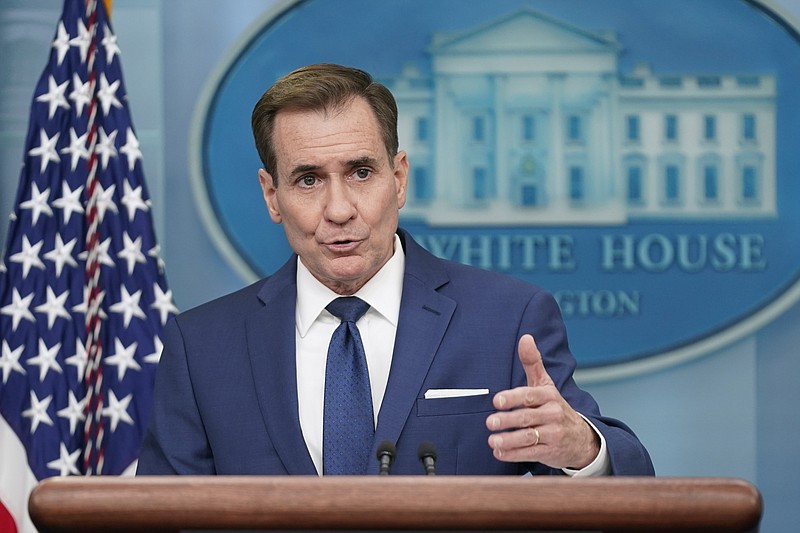WASHINGTON -- The U.S. will send $3.75 billion in military weapons and other aid to Ukraine and its neighbors on NATO's eastern flank, the White House announced Friday, as Russia's invasion of Ukraine grinds on.
For the first time, the latest tranche of assistance will include Bradley armored vehicles for Ukraine. The armored carrier is used to transport troops to combat and is known as a "tank-killer" because of the anti-tank missile it can fire.
The biggest U.S. assistance package to date for Kyiv includes a $2.85 billion drawdown from the Pentagon's stocks that will be sent directly to Ukraine and $225 million in foreign military financing to build the long-term capacity and support modernization of Ukraine's military, according to the White House. It also includes $682 million in foreign military financing for European allies to help backfill donations of military equipment they've made to Ukraine.
"The war is at a critical point and we must do everything we can to help the Ukrainians resist Russian aggression," White House press secretary Karine Jean-Pierre said in announcing the aid.
The direct assistance for Ukraine includes 50 Bradleys as well as 500 anti-tank missiles and 250,000 rounds of ammunition for the carriers. The U.S. is also sending 100 M113 armored personnel carriers, 55 mine-resistant ambush protected vehicles, or MRAPS, and 138 Humvees, as well as ammunition for High Mobility Artillery Rocket Systems and air defense systems and other weapons and thousands of rounds of artillery, according to the Pentagon.
White House National Security Council spokesman John Kirby said the Bradleys will be particularly useful to Ukraine in ongoing heavy fighting in largely rural areas of eastern Ukraine.
"It's very much tied to the war that we're seeing on the ground right now and what we anticipate we'll see throughout the winter months," Kirby said.
Critics have complained that the U.S. has been too slow to provide key weapons such as the Bradleys and battle tanks like the Abrams, saying they could have helped in the fight last year.
At the Pentagon, Laura Cooper, the deputy assistant secretary for Russia and Ukraine, said this is the right time to provide the Bradley. "The Ukrainians have demonstrated a lot of growing proficiency in maintenance and sustainment," she said.
She added that the U.S.-led training set to begin later this month will enable troops to operate, maintain and repair the weapons and that providing tanks, such as the Pentagon's more complex, gas-guzzling, heavily armored M1 Abrams tank, would require more maintenance and other training.
The new U.S. package was detailed by the White House and Pentagon as Germany announced it would supply around 40 Marder armored personnel carriers to Ukraine in this year's first quarter.
Germany announced its intention to send the Marder APCs after a phone call between Chancellor Olaf Scholz and President Joe Biden on Thursday.
"These 40 vehicles should be ready in the first quarter already so that they can be handed over to Ukraine," Scholz's spokesman, Steffen Hebestreit, told reporters in Berlin. Germany plans to train Ukrainian forces to use the vehicles, and Hebestreit said experts expect that process to take around eight weeks.
Germany has already given significant military aid, including howitzers, Gepard self-propelled anti-aircraft guns and an IRIS-T surface-to-air missile system, with three more of those set to follow this year.
DRONE SANCTIONS
In other defense developments Friday, the U.S. hit six executives and board members of an Iranian drone manufacturer with sanctions after the firm was alleged to have supplied Moscow with drones that Russian forces have been using to attack Ukraine.
Qods Aviation Industries, a previously sanctioned Iranian defense manufacturer, is alleged to be responsible for the design and production of unmanned aerial vehicles used to conduct strikes on civilians during Russia's invasion of Ukraine. The Treasury Department says the firm changed its name to Light Airplanes Design and Manufacturing Industries in mid-2020 to evade sanctions.
The financial penalties imposed by Treasury's Office of Foreign Assets Control highlight the growing tension between the U.S. and Iran over reviving the 2015 nuclear deal as well as U.S. allegations of Russia and Iran deepening cooperation through shared military assistance as the war rages on.
"Iran has now become Russia's top military backer," Secretary of State Antony Blinken said in a statement. "Iran must cease its support for Russia's unprovoked war of aggression in Ukraine, and we will continue to use every tool at our disposal to disrupt and delay these transfers and impose costs on actors engaged in this activity."
The latest sanctions follow a round imposed on Iranian-based Shahed Aviation Industries Research Center, which the U.S. says designs and produces drones used by Russian forces in Ukraine, and several firms that are said to facilitate the transfer of Iranian drones to Russia.
Information for this article was contributed by Fatima Hussein, Seung Min Kim and Aamer Madhani of The Associated Press.

